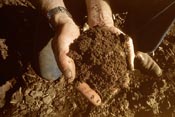Become a worm farmer: easy food scrap composting
by Doug Collins, Seattle Tilth
This article was originally published in June 2004

(June 2004) — Composting food waste can be a fun and easy way to be an active environmental steward. A definition of composting I like is, “The controlled decomposition of organic matter.”
The key word is “controlled,” and that’s why it’s important to be savvy about composting systems. Two easy composting systems for food scraps are food digesters and worm bins. These systems are a great way to turn most any food, except meat and dairy, into compost.
Food digesters can be made out of garbage cans or purchased commercially. Digesters have a tight-fitting lid, holes in the bottom for water drainage, and holes along the sides that allow worms and other soil animals to migrate into the composting area.
To install and use the digester, dig a hole one-and-a-half to two feet deep. Place the digester in the hole, fill in with dirt around the sides, and start putting food scraps into the bin. Occasionally cover the food with a layer of shredded paper, wood shavings, brown leaves, straw or similar carbon-based material.
After several months, the digester will be nearly full. It takes maybe nine to twelve months for the material to convert to usable compost. In the meantime, start a second digester.
The convenience of food digesters is their easy set-up, no hassle use, and passive interaction with leftover food. One drawback is that they tend to be a friendly breeding ground for fruit flies. Adding a layer of dirt or other brown matter (as above) on top helps minimize this. Also, if placed at a safe distance from windows or doors, the fruit flies aren’t much of an annoyance.
Worm bins are, in my opinion, the most interesting and rewarding food waste composting technique. If you’ve a desire for animal husbandry, but don’t live in a space that allows you to raise cows or sheep, worms are livestock that you can handle.
A worm bin is a system managed to create an ideal habitat for worms to grow and reproduce. The composting worm (a.k.a. manure worm, red wiggler or Eisenia fetida) is a natural litter-dweller and is happiest in environments rich in organic matter. The steps to becoming a successful worm farmer are: get a bin, add bedding and worms, and start feeding them.
Worm bins can be made easily and inexpensively, or purchased. Moisten brown leaves, cardboard, newspaper or wood shavings before putting them into the bin, and add worms and food scraps.
After several months, most of the bedding and food will convert to rich worm castings (excrement). Simply push this material to one side of the bin and start on the other side with new bedding. Put food in the new bedding and your herd of worms will migrate towards the food. After another month or so, the compost pushed to the side can be harvested for use, more bedding added, and the process continued.
Food burial, though not much of a system, is an acceptable method as well. Food covered with at least eight inches of soil is safe from rodents. If properly buried, nature will do the rest, leaving behind soil enriched in organic matter and valuable plant nutrients.
For information on building or using food-composting systems, call the Natural Lawn & Garden Hotline at 206-633-0224, or find it online at www.ci.seattle.wa.us/util/composting/.
Become a worm farmer today!
